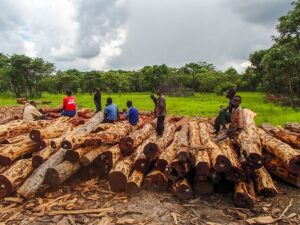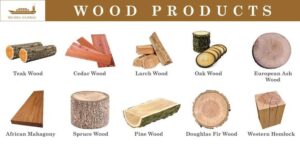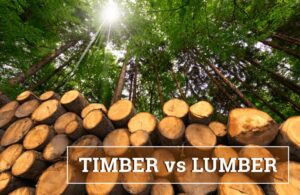Back to: Botany 500 Level
Hello, bright botanist!
I hope you’re doing fantastic today. We’ve got another fascinating topic to look into: Timber Species, Uses, and Trade. Timber has always been an important part of human civilization, especially here in Nigeria, where forests and woodlands are crucial to local economies and lifestyles. Today, we’re going to explore different timber species found in Nigeria, their uses, and the trade surrounding them. Let’s get started!
Timber species, uses, and trade
Timber is one of Nigeria’s most valuable natural resources. It’s not only used for construction, furniture making, and firewood but also plays a significant role in the economy. Timber from different species of trees has varying qualities, which makes them suitable for specific uses. In this lesson, we’ll examine some of the prominent timber species found in Nigeria, how they are used in daily life, and the trade practices associated with them. By the end, you’ll have a deeper understanding of how timber contributes to the environment, economy, and culture of Nigeria.

Body – Timber Species, Uses, and Trade
- Important Timber Species in Nigeria
- Mahogany (Khaya spp.)
- Uses: Mahogany is one of the most popular timber species in Nigeria, known for its strength and durability. It is primarily used for making furniture, doors, window frames, and interior décor. It is also used in boat building due to its resistance to water.
- Trade: Mahogany has a high demand both locally and internationally. However, overharvesting in the past has led to concerns about the sustainability of mahogany timber trade. This has resulted in stricter regulations and efforts to promote sustainable forest management practices.
- Iroko (Milicia excelsa)
- Uses: Iroko wood is known for its rich, reddish-brown colour and is often used in the construction of buildings, furniture, and flooring. It is also used for making carvings and sculptures, particularly in Nigeria’s traditional arts and crafts.
- Trade: Iroko is highly prized and is often exported to other countries. However, like mahogany, excessive logging of Iroko trees has raised concerns about the depletion of these forests, leading to the promotion of responsible forestry practices.
- Ebony (Diospyros spp.)
- Uses: Ebony is known for its fine texture and dark colour, making it ideal for making high-end furniture, musical instruments, and carvings. It is also used in the making of luxury items like piano keys and jewellery.
- Trade: Ebony has a significant demand, both locally and internationally. Due to its high value, there are concerns about over-exploitation, leading to various efforts to protect this species from over-harvesting.
- Teak (Tectona grandis)
- Uses: Teak wood is durable and resistant to water, making it ideal for outdoor furniture, decking, and shipbuilding. It is also used in the construction of houses, especially in coastal regions of Nigeria where water resistance is essential.
- Trade: While teak is not native to Nigeria, it has been introduced in many parts of the country and is widely cultivated. The timber trade of teak is significant, with both local and international markets demanding it for various uses.
- Mahogany (Khaya spp.)
- Timber Uses in Nigerian Communities
- Building Materials: In Nigeria, timber is commonly used as a primary building material in both urban and rural areas. In urban areas, high-quality timber species like mahogany and iroko are used in the construction of homes, offices, and public buildings. In rural areas, timber is used in building traditional houses, furniture, and fences.
- Furniture Making: Timber is also used extensively in furniture making, from simple chairs and tables to elaborate carved pieces of furniture. Ebony, mahogany, and iroko are popular choices for artisans and manufacturers.
- Fuelwood: In many parts of Nigeria, especially in rural areas, wood is an essential source of fuel for cooking. Firewood from various tree species is gathered, though unsustainable harvesting practices have led to the depletion of forest resources.
- Art and Craft: Timber species such as Iroko, Ebony, and Mahogany are also used in the production of traditional art and crafts. Carvings, sculptures, and masks made from these timbers are important parts of Nigeria’s cultural heritage.
- Timber Trade in Nigeria
- Domestic Trade: Timber is traded locally across Nigeria. In major cities like Lagos, Port Harcourt, and Kano, timber merchants supply wood for construction and furniture making. The trade of timber is regulated by both federal and state governments to ensure sustainable harvesting and prevent illegal logging.
- Export Trade: Nigeria is a significant exporter of timber, particularly to countries in Europe, Asia, and the Americas. The export of timber contributes to the country’s economy, but concerns about over-exploitation and deforestation have led to stricter controls and policies.
- Challenges in the Timber Trade: One of the main challenges facing the timber trade in Nigeria is illegal logging. Many forests are being cut down unsustainably, threatening biodiversity and contributing to climate change. In response, Nigeria has adopted policies to ensure the responsible and sustainable use of its forest resources, including the establishment of forest reserves and the implementation of a National Forest Policy.

Why It’s Important to Understand Timber Species, Uses, and Trade
- Environmental Conservation: Understanding the importance of sustainable timber trade is essential for conserving Nigeria’s forests. Over-harvesting timber without proper replanting and management leads to deforestation, which can have significant environmental consequences, such as loss of biodiversity, soil erosion, and climate change.
- Economic Contribution: The timber industry contributes significantly to Nigeria’s economy by providing employment opportunities in forestry, timber trade, furniture making, and construction. It is vital for students and practitioners in botany to understand how timber contributes to the local and national economy.
- Cultural Heritage: Timber species like Iroko and Ebony are not just commercial resources; they are also part of Nigeria’s rich cultural heritage. They are used in art, craftsmanship, and traditional rituals, which helps preserve the country’s history and cultural identity.

Real-Life Gist
Imagine visiting a furniture market in Lagos, where you see artisans crafting beautiful wooden chairs, tables, and cabinets from mahogany and iroko. These pieces are not only made to last but also tell a story of tradition and skill passed down through generations. As you walk through, you realise that this timber trade supports the livelihoods of many families, but you also hear about the need to protect the forests where these trees grow, ensuring future generations can enjoy these resources.
Summary:
- Timber species like Mahogany, Iroko, Ebony, and Teak are used in Nigeria for a variety of purposes, from construction to furniture making, art, and fuel.
- The timber trade contributes significantly to Nigeria’s economy, but concerns over illegal logging and deforestation highlight the need for sustainable forestry practices.
- Protecting Nigeria’s forests and promoting responsible timber trade ensures that future generations can continue to benefit from these resources.
Evaluation:
- What are some of the uses of Iroko timber in Nigerian communities?
- What are the challenges facing the timber trade in Nigeria?
- Why is it important to ensure sustainable timber trade practices?
You’ve now gained a deeper understanding of timber species in Nigeria, their uses, and the trade surrounding them. This is valuable knowledge that connects science, economy, and culture. Keep up the great work! You’re one step closer to becoming a well-rounded botanist. Stay curious and keep exploring – the next lesson awaits!
